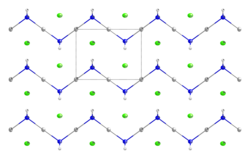Top Qs
Timeline
Chat
Perspective
Mercuric amidochloride
Chemical compound From Wikipedia, the free encyclopedia
Remove ads
Mercuric amidochloride is an inorganic compound with the formula Hg(NH2)Cl.
Remove ads
Preparation and properties
Summarize
Perspective
It arises from the reaction of mercury(II) chloride and ammonia (Calomel reaction), where the resulting mercuric amidochloride is highly insoluble.[citation needed]
It forms white crystals in the shape of small prisms. It has been described as having an earthy, metallic flavor.[2]
At the molecular level, it organizes as a zig-zag one-dimensional polymer (HgNH2)n with chloride counterions.[7][8]

It is stable in air, but darkens on exposure to light.[9] It does not melt, even at dull red heat, instead subliming and decomposing to gaseous mercury, hydrogen chloride, and nitrogen oxides.[3][10] Consequently sealed containers with this chemical may explode when heated.[11]
The substance is a lethal poison.[2] It is toxic by inhalation, ingestion or dermal absorption. In lesser cases,[which?] it may instead cause dermatitis and skin lesions[9] or corrode the mucous membranes.[failed verification]
Addition of base converts it into "Millon's base", named after Eugène Millon, which has the formula Hg2(OH)N·xH2O. A variety of related amido and nitrido materials with chloride, bromide, and hydroxide are known.[12][page needed]
Remove ads
Uses
Before the toxicity of mercury was revealed,[when?] mercuric amidochloride, then known as ammoniated mercury or white precipitate, was used as a topical skin antiseptic, especially for impetigo, dermatomycosis and other certain dermatoses.[13]
It was also used for scaling in psoriasis, to treat pruritus ani, and against pinworm and ringworm infection (especially in dogs), against crab louse infestation, against lesions on the body and near eyes, against bumblefoot infection on poultry, and as a disinfectant.[9][13]
Chronic use of this medication can lead to systemic mercury poisoning.[9]
Remove ads
See also
- Merbromin, also known as "Mercurochrome", another antiseptic mercury compound
- Thiomersal, another antiseptic mercury compound
References
Wikiwand - on
Seamless Wikipedia browsing. On steroids.
Remove ads




